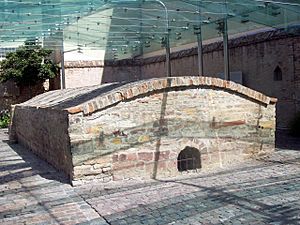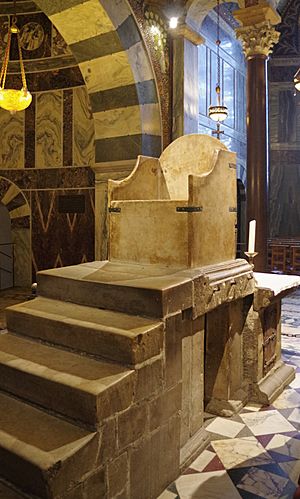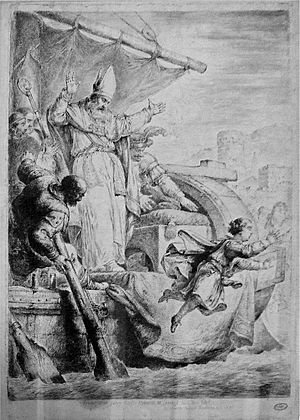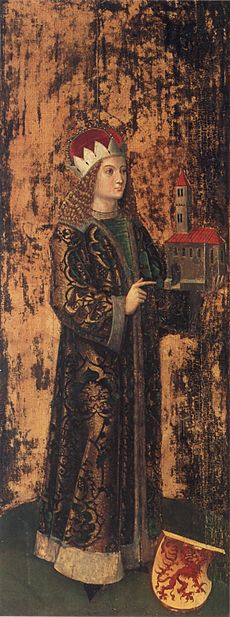Henry IV, Holy Roman Emperor facts for kids
Quick facts for kids Henry IV |
|
|---|---|

Henry in full regalia (depicted in the 11th-century Evangelion of Saint Emmeram's Abbey)
|
|
| Holy Roman Emperor | |
| Reign | 1084–1105 |
| Coronation |
|
| Predecessor | Henry III |
| Successor | Henry V |
| King of Germany | |
| Reign | 1054–1105 |
| Coronation |
|
| Predecessor | Henry III |
| Successor | Henry V |
| King of Italy and Burgundy | |
| Reign | 1056–1105 |
| Predecessor | Henry III |
| Successor | Henry V |
| Born | 11 November 1050 Imperial Palace of Goslar, Saxony (?) |
| Died | 7 August 1106 (aged 55) Liège, Lower Lorraine |
| Burial | Speyer Cathedral |
| Spouse |
Bertha of Savoy
(m. 1066; died 1087)Eupraxia of Kiev
(m. 1089; div. 1095) |
| Issue |
|
| House | Salian dynasty |
| Father | Henry III, Holy Roman Emperor |
| Mother | Agnes of Poitou |
| Religion | Roman Catholic |
Henry IV (born 11 November 1050 – died 7 August 1106) was a powerful ruler in medieval Europe. He was the Holy Roman Emperor from 1084 to 1105. He also held titles like King of Germany, King of Italy, and King of Burgundy. Henry was part of the Salian dynasty, a family that ruled Germany for over a century.
When his father, Henry III, died in 1056, Henry IV was only six years old. His mother, Agnes of Poitou, became his guardian. During this time, the idea of the "liberty of the Church" grew stronger. This meant the Church wanted more independence from rulers. In 1062, Archbishop Anno II of Cologne kidnapped young Henry. Anno then ruled Germany until Henry became old enough to rule on his own in 1065.
Henry tried to get back royal lands that were lost when he was a child. He also appointed common people to important jobs. This made many powerful German nobles unhappy. Henry also believed he had the right to appoint bishops and abbots. However, Church reformers saw this as simony, which was the forbidden sale of church offices. These disagreements led to major conflicts between Henry and the Church.
Contents
Henry IV and the Church
Henry's conflicts with the Church became very serious. Pope Gregory VII threatened to excommunicate him for appointing church officials. Excommunication meant being cast out of the Church.
The Pope's Power Challenged
In January 1076, Henry convinced many German bishops to say the Pope's election was not valid. In response, Pope Gregory VII excommunicated Henry. He also told Henry's subjects they no longer had to obey him. This was a huge deal because no pope had ever done this to a monarch before.
German nobles who were against Henry wanted the Pope to come to Germany. They wanted the Pope to judge Henry's case. Henry did not want the Pope to judge him in Germany. So, he decided to go to Italy to meet the Pope.
The Walk to Canossa
In January 1077, Henry traveled to Canossa in Italy. It was a very cold winter. For three days, Henry stood barefoot in the snow outside the castle, wearing simple clothes. He was showing he was sorry for his actions. This event is known as the "Walk to Canossa".
The Pope had no choice but to forgive him. Henry promised to accept the Pope's judgment in his conflicts. However, Henry's German opponents ignored this forgiveness. They elected a new king, Rudolf of Rheinfelden, in March 1077.
Civil War and Second Excommunication
The Pope stayed neutral at first, which helped Henry get stronger. Henry continued to appoint church leaders. Because of this, the Pope excommunicated him again in March 1080. Most German and Italian bishops stayed loyal to Henry. They elected their own pope, Antipope Clement III.
Rudolf of Rheinfelden was killed in battle. His successor, Hermann of Salm, had little power. From 1081, Henry launched military campaigns in Italy. Clement III crowned Henry as Holy Roman Emperor in Rome on 1 April 1084.
Henry's Reign as Emperor
After becoming emperor, Henry worked to bring peace to his lands.
Bringing Peace to the Empire
Hermann of Salm died in 1088. Henry then made peace with the nobles in Saxony. In 1089, he attacked Matilda of Tuscany, a strong ally of the Pope. Matilda convinced Henry's older son, Conrad, to fight against his father in 1093.
Matilda's alliance with Welf I, Duke of Bavaria, stopped Henry from returning to Germany. He finally made peace with Welf in 1096 and could go back. After Clement III died, Henry did not support new antipopes. However, he did not make peace with Pope Paschal II.
In 1103, Henry announced the first Reichsfriede (imperial peace). This was a law that covered all of Germany. It aimed to stop fighting and violence.
His Son's Rebellion and Fall
Henry's younger son, Henry V, forced him to give up his throne on 31 December 1105. Henry IV tried to get his throne back with help from nobles in Lorraine. But he became sick and died. He died without being forgiven by the Pope for his excommunication.
Henry IV's life was full of conflict. His "Walk to Canossa" and his fights with the popes, his sons, and his wives made him a controversial figure. Some people saw him as a harsh ruler. Others saw him as a good king who protected the poor.
Early Life and Becoming King
Henry was born on 11 November 1050. His father was Emperor Henry III, and his mother was Agnes of Poitou. He was likely born in his father's palace in Goslar. His birth was very important because his parents had only daughters before him.
A Young King's Start
Henry was named after his grandfather, Conrad II, Holy Roman Emperor. But his godfather, Abbot Hugh of Cluny, convinced his father to name him Henry instead. In 1052, his father made him the Duke of Bavaria.
Archbishop Hermann crowned Henry as King of Germany in Aachen on 17 July 1054. When his younger brother, Conrad, died in 1055, Henry's mother, Empress Agnes, received Bavaria. Henry was also engaged to Bertha of Savoy in 1055. Her family controlled important parts of northern Italy.
Henry III became very ill in September 1056. He died on 5 October 1056. Henry IV became king at just six years old.
Guardianship and Challenges
After his father's death, Pope Victor II helped Henry become king in Aachen. Henry's mother, Empress Agnes, became his guardian. She gave out many gifts to powerful nobles to get their support.
However, Agnes struggled to control the Church. The idea that the Church should be free from royal control grew stronger. In 1058, a new pope, Nicholas II, was elected without the king's involvement. This was a big change from how things used to be.
The Kaiserswerth Coup
In April 1062, Archbishop Anno II of Cologne and other nobles kidnapped Henry. They tricked him onto a ship near Kaiserswerth. Henry, fearing for his life, jumped into the river. He was saved by Egbert of Brunswick. This event is known as the "Coup of Kaiserswerth".
After the coup, Empress Agnes stepped down as regent. Anno took over the government and Henry's education. Anno worked to end a split in the Church. He also helped Henry gain his first military experience in Hungary in 1063.
Coming of Age and Early Rule
Henry officially became an adult at a ceremony in Worms on 29 March 1065. He soon removed Archbishop Anno from his court. Archbishop Adalbert of Bremen then took control of the government.
Adalbert and his friends used their power to take church property and accept bribes. This caused a scandal. In January 1066, Henry was convinced to dismiss Adalbert. After this, no single advisor had full control over Henry's government.
Henry became very ill in May 1066. People thought he might die. After he recovered, he quickly married Bertha of Savoy. This was likely to ensure a clear successor and calm fears about the future of the kingdom.
Later Years and Legacy
Henry's reign was marked by constant struggles for power.
Conflicts and Compromises
After Pope Gregory VII died in 1085, Henry tried to strengthen his position. He rewarded loyal supporters and punished his enemies. He even made Vratislaus II of Bohemia a king in 1085.
However, rebellions continued. Henry's opponents defeated his army in the Battle of Pleichfeld in 1086. In 1087, Henry had his son, Conrad, crowned as his co-ruler. This was to secure the family's hold on the throne.
In 1088, one of the main rebel leaders, Egbert II of Brunswick, swore loyalty to Henry. This helped break up the Saxon rebellion. Henry also married his second wife, Eupraxia of Kiev, in 1089.
Return to Italy and Family Troubles
Henry invaded Matilda of Tuscany's lands in 1090. He also issued important documents protecting the rights of Jewish communities in Speyer and Worms. These documents protected them from attacks and forced baptisms.
In 1093, Henry's son, Conrad, turned against him. This made Henry suspicious of his family. His wife, Eupraxia, also left him in 1094. She made serious accusations against him at a Church council in 1095. The Pope supported Conrad's claim to the throne.
Reconciliation and Final Years
In 1096, Henry finally made peace with Welf of Bavaria. This allowed Henry to return to Germany. Many nobles who had rebelled against him now pledged loyalty. In 1098, the German nobles and bishops removed Conrad as co-ruler. They elected Henry's younger son, Henry V, as the new co-ruler. Conrad died forgotten in Tuscany.

Henry continued to work on restoring order. In 1103, he announced the Reichsfriede, a peace law for the entire empire. He also hinted at wanting to go on a crusade, possibly to make peace with the Pope.
Abdication and Death
In 1104, Henry's younger son, Henry V, rebelled against him. Henry V said his father's excommunication was the reason. Most nobles joined the younger Henry. In December 1105, Henry IV was forced to give up his royal symbols to his son. He officially abdicated on 31 December 1105.
Henry IV tried to regain his throne with the help of some nobles. His supporters even defeated his son's army in March 1106. But Henry IV became sick and died in Liège on 7 August 1106. He asked to be buried with his ancestors in Speyer Cathedral.
Because he was excommunicated, Henry's body was first buried in an unconsecrated chapel. Five years later, Pope Paschal II allowed his son to bury him properly. Henry IV was finally buried next to his father in Speyer Cathedral on 7 August 1111.
Henry's Family
Henry's first wife was Bertha of Savoy. They married in 1066. Henry tried to divorce her in 1069, but the Pope stopped him. Bertha died in 1087.
Bertha and Henry had five children, but two died young. Their surviving children were:
- Agnes, born around 1072 or 1073.
- Conrad, born in 1074, who rebelled against his father.
- Henry, born in 1086, who later dethroned his father.
Henry's second wife was Eupraxia of Kiev, also known as Adelaide. They married in 1089. Their marriage ended in scandal, and Eupraxia returned to Kiev.
| Henry's family | |||||||||||||||||||||||||||||||||||||||||||||||||||||||||||||||||||||||||||||||||||||||||||||||||||||||||||||||||||||||||||||||||||||||||||||||||||||||||||||||||||||||||||||||||||||||||||||||||||||||||||||||||||||||||||||||||||||||||||||||||||||||||||||||||||||||||||||||||||||||||||||||||||||||||||||||||||||||||||||||||||||||||||||||||||||||||||||||||||||||||||||||||||||||||||||||||||||||||||||||||||||||||||||||||||||||||||||||||||||||||||||||||||||||||||||||||||||||||||||||||||||||||||||||||||||||||||||||||||||||||||||||||||||||||||||||||||||||||||||||||||||||||||||||||||||||||||||||||||||||||||||||||||||||||||||||||||||||||||||||||||||||||||||||||||||||||||||||||||||||||||||||||||||||||||||||||||||||||||||||||||||||||||||||||||||||||||||||||||||||||||||||||||||||||||||||||||||||||||||||||||||||||||||||||||||||||||||||||||||||||||||||||||||||||||||||||||||||||||||||||||||||||||||||||||||||||||||||||||||||||||||||||||||||||||||||||||||||||||||||||||||||||||||||||||||||||||||||||||||||
|---|---|---|---|---|---|---|---|---|---|---|---|---|---|---|---|---|---|---|---|---|---|---|---|---|---|---|---|---|---|---|---|---|---|---|---|---|---|---|---|---|---|---|---|---|---|---|---|---|---|---|---|---|---|---|---|---|---|---|---|---|---|---|---|---|---|---|---|---|---|---|---|---|---|---|---|---|---|---|---|---|---|---|---|---|---|---|---|---|---|---|---|---|---|---|---|---|---|---|---|---|---|---|---|---|---|---|---|---|---|---|---|---|---|---|---|---|---|---|---|---|---|---|---|---|---|---|---|---|---|---|---|---|---|---|---|---|---|---|---|---|---|---|---|---|---|---|---|---|---|---|---|---|---|---|---|---|---|---|---|---|---|---|---|---|---|---|---|---|---|---|---|---|---|---|---|---|---|---|---|---|---|---|---|---|---|---|---|---|---|---|---|---|---|---|---|---|---|---|---|---|---|---|---|---|---|---|---|---|---|---|---|---|---|---|---|---|---|---|---|---|---|---|---|---|---|---|---|---|---|---|---|---|---|---|---|---|---|---|---|---|---|---|---|---|---|---|---|---|---|---|---|---|---|---|---|---|---|---|---|---|---|---|---|---|---|---|---|---|---|---|---|---|---|---|---|---|---|---|---|---|---|---|---|---|---|---|---|---|---|---|---|---|---|---|---|---|---|---|---|---|---|---|---|---|---|---|---|---|---|---|---|---|---|---|---|---|---|---|---|---|---|---|---|---|---|---|---|---|---|---|---|---|---|---|---|---|---|---|---|---|---|---|---|---|---|---|---|---|---|---|---|---|---|---|---|---|---|---|---|---|---|---|---|---|---|---|---|---|---|---|---|---|---|---|---|---|---|---|---|---|---|---|---|---|---|---|---|---|---|---|---|---|---|---|---|---|---|---|---|---|---|---|---|---|---|---|---|---|---|---|---|---|---|---|---|---|---|---|---|---|---|---|---|---|---|---|---|---|---|---|---|---|---|---|---|---|---|---|---|---|---|---|---|---|---|---|---|---|---|---|---|---|---|---|---|---|---|---|---|---|---|---|---|---|---|---|---|---|---|---|---|---|---|---|---|---|---|---|---|---|---|---|---|---|---|---|---|---|---|---|---|---|---|---|---|---|---|---|---|---|---|---|---|---|---|---|---|---|---|---|---|---|---|---|---|---|---|---|---|---|---|---|---|---|---|---|---|---|---|---|---|---|---|---|---|---|---|---|---|---|---|---|---|---|---|---|---|---|---|---|---|---|---|---|---|---|---|---|---|---|---|---|---|---|---|---|---|---|---|---|---|---|---|---|---|---|---|---|---|---|---|---|---|---|---|---|---|---|---|---|---|---|---|---|---|---|---|---|---|---|---|---|---|---|---|---|---|---|---|---|---|---|---|---|---|---|---|---|---|---|---|---|---|---|---|---|---|---|---|---|---|---|---|---|---|---|---|---|---|---|---|---|---|---|---|---|---|---|---|---|---|---|---|---|---|---|---|---|---|---|---|---|---|---|---|---|---|---|---|---|---|---|---|---|---|---|---|---|---|---|---|---|---|---|---|---|---|---|---|---|---|---|---|---|---|---|---|---|---|---|---|---|---|---|---|---|---|---|---|---|---|---|---|---|---|---|---|---|---|---|---|---|---|---|---|---|---|---|---|---|---|---|---|---|---|---|---|---|---|---|---|---|---|---|---|---|---|---|---|---|---|---|---|---|---|---|---|---|---|---|---|---|---|---|---|---|---|---|---|---|---|---|---|---|---|---|---|---|---|---|---|---|---|---|---|---|---|---|---|---|---|---|---|---|---|---|---|---|---|---|---|---|---|---|---|---|---|---|---|---|---|---|---|---|---|---|---|---|---|---|---|---|---|---|---|---|---|---|---|---|---|---|---|---|---|---|---|---|---|---|---|---|---|---|---|---|---|---|---|---|---|---|---|---|---|---|---|---|---|---|---|---|---|---|---|---|---|---|---|---|---|---|---|---|---|---|---|---|---|---|---|---|---|---|---|---|---|---|---|---|---|---|---|---|---|---|---|---|---|---|---|---|---|---|---|---|---|---|---|---|---|---|---|---|---|---|---|---|---|---|---|---|---|---|---|---|---|---|---|---|---|---|---|---|---|---|---|---|---|---|---|---|---|---|---|---|---|---|---|---|---|---|---|---|---|---|---|---|---|---|---|---|---|---|---|---|---|---|---|---|---|---|---|---|---|---|---|---|---|---|---|---|---|---|---|---|---|---|---|---|---|---|---|---|---|---|---|---|---|
|
|||||||||||||||||||||||||||||||||||||||||||||||||||||||||||||||||||||||||||||||||||||||||||||||||||||||||||||||||||||||||||||||||||||||||||||||||||||||||||||||||||||||||||||||||||||||||||||||||||||||||||||||||||||||||||||||||||||||||||||||||||||||||||||||||||||||||||||||||||||||||||||||||||||||||||||||||||||||||||||||||||||||||||||||||||||||||||||||||||||||||||||||||||||||||||||||||||||||||||||||||||||||||||||||||||||||||||||||||||||||||||||||||||||||||||||||||||||||||||||||||||||||||||||||||||||||||||||||||||||||||||||||||||||||||||||||||||||||||||||||||||||||||||||||||||||||||||||||||||||||||||||||||||||||||||||||||||||||||||||||||||||||||||||||||||||||||||||||||||||||||||||||||||||||||||||||||||||||||||||||||||||||||||||||||||||||||||||||||||||||||||||||||||||||||||||||||||||||||||||||||||||||||||||||||||||||||||||||||||||||||||||||||||||||||||||||||||||||||||||||||||||||||||||||||||||||||||||||||||||||||||||||||||||||||||||||||||||||||||||||||||||||||||||||||||||||||||||||||||||||
*Gunhilda's daughter by Emperor Henry III, Beatrix, is not displayed. She was Abbess of Quedlinburg and Gandersheim until her death in 1061.
See also
 In Spanish: Enrique IV del Sacro Imperio Romano Germánico para niños
In Spanish: Enrique IV del Sacro Imperio Romano Germánico para niños
- Family tree of German monarchs
- Henry IV (Pirandello)






